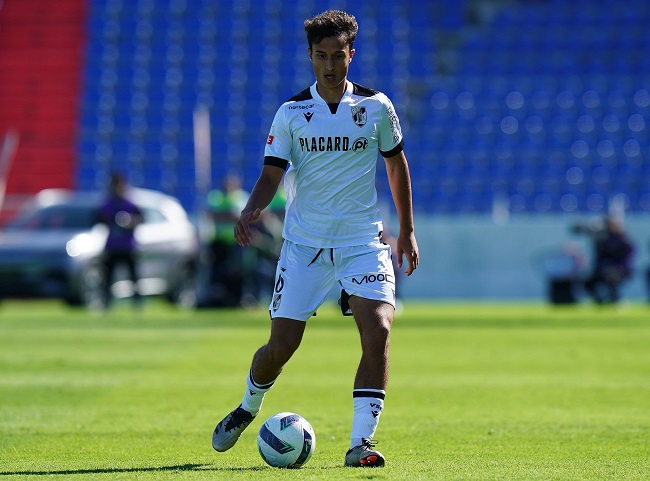In a summer of upheaval and new beginnings, the Serbian midfielder emerges as the piece that helps explain where Vitória want to go — and, more importantly, how they plan to get there.

Arriving in Guimarães quietly and without much fanfare, Matija Mitrović has quickly become one of the most intriguing new faces in the Vitória SC squad. The 20-year-old Serbian midfielder joined from Železničar Pančevo in a deal worth around €900,000, a significant investment for a player still in the early stages of his professional development and coming from a league with limited international exposure.
His signing comes at a moment of major transition for Vitória. The club went through a summer of structural change, marked by the departures of the captains Tiago Silva and goalkeeper Bruno Varela, and several other key figures such as Toni Borevkovic, Nuno Santos, and Filipe Relvas. The departure of Tomás Händel, the academy-bred midfielder seen as the natural heir to lead the team in the coming years, added an emotional layer to a rebuilding process already underway.
Squad overhaul
To illustrate the scale of the turnover: of the 16 players who featured in the final match of the 2024/25 season — away to Sporting CP in May — only seven remain part of the current squad.
Recent comments from club president António Miguel Cardoso shed light on the direction Vitória intends to follow. He spoke openly about the need for less vanity and more humility inside the dressing room, stressing that the club had to recover its competitive hunger and collective identity. Cardoso also highlighted the emphasis on youth — seven new signings aged 23 or under — and the ambition to promote internal talent while building a sustainable, committed core for the future.
Within that context, Matija Mitrović feels like a natural addition to the new direction Vitória seem to be pursuing: a young player with clear potential, technical quality, and the right temperament to grow within a rebuilding environment. Amid the noise that often accompanies such transitions, the Serbian stands out for precisely the opposite traits — composure, clarity, and control.
Maturity
Despite his age, he already shows a striking maturity in how he positions himself to collect the ball, dictates tempo and connects different sectors of play. He’s a proper midfielder, always scanning, comfortable operating between lines and capable of initiating attacking phases through intelligent positioning and passing. His first touch and quick reading of pressure allow him to escape tight situations and keep possession flowing naturally. Beyond passing and positional awareness, Mitrović also offers a threat from distance, equipped with a powerful, precise shot — something Braga’s Lukáš Horníček found out the hard way — and a confident delivery from set pieces.
Under Luís Pinto, Vitória have been lining up in a 4-2-3-1 system designed to balance structure and freedom. Within the double pivot, one midfielder provides defensive cover and stability, while the other is given more licence to dictate tempo and progress play. Mitrović clearly fits the latter description — he’s an architect and engineer in possession.
Operating mostly on the left side of that double pivot, he positions himself between opposition lines, helping Vitória play out from deeper areas with greater purpose. His composure on the ball and ability to turn under pressure allow the team to move up the pitch in a more connected, cohesive way. He doesn’t rush decisions — he times them. Knowing when to pause and when to accelerate is what makes his game stand out.
Even so, his impact remains more visible with the ball than without it. He still lacks a bit of bite in duels, intensity in transitions and positional consistency when defending. For a team that demands collective commitment in the moments immediately after losing possession, those are areas he’ll need to develop.
Adapting
That’s less a question of willingness than of adaptation. In Serbia, the tempo was slower, the distances shorter, and defensive recovery less disciplined. In Portugal, transitions are, at times, frequent and physical demands far higher — an inevitable learning curve for a young midfielder adjusting to a more dynamic league. If he can match his technical ability with greater off-ball intensity, he has the tools to become a reliable and well-rounded option for Vitória.
The departure of Tomás Händel left behind more than a tactical void. It left a symbolic one — a homegrown player who embodied the connection between pitch and stands, between the club’s roots and its ambitions. Mitrović, though not a product of the Guimarães academy, arrives at a moment when his age, potential and style could allow him to inherit part of that emotional link. There’s genuine curiosity around his evolution and a sense among supporters that he could grow into someone they identify with. Given time and the right structure, he could become what Händel once promised to be: a midfielder for the future, and perhaps a figure capable of embodying Vitória’s renewed identity.
Ultimately, Matija Mitrović’s arrival represents more than just another youthful signing. It reflects a Vitória SC in search of definition — a club betting on youth and potential but now needing stability and continuity to make that vision tangible. If the project around him finds balance, Mitrović could become one of its cornerstones, turning potential into consistency and promise into purpose.
André Lopes is a Lisbon-based football analyst focusing on player scouting and tactical trends in Portuguese football. You can find more of his in-depth work (in Portuguese) at andreglopes.substack.com.

